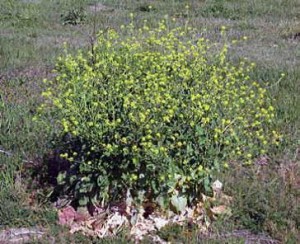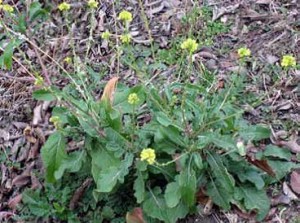 There once was a wonderful wildflower site near Aledo, Texas, along Iona road. It was a cattle-range field that I would drive past each spring to watch the glorious diversity of Texas wildflowers color the landscape in rainbows of bluebonnets and orange paintbrush, and a dozen other wildflowers all blooming in natural diversity.
There once was a wonderful wildflower site near Aledo, Texas, along Iona road. It was a cattle-range field that I would drive past each spring to watch the glorious diversity of Texas wildflowers color the landscape in rainbows of bluebonnets and orange paintbrush, and a dozen other wildflowers all blooming in natural diversity.
One year I noticed stands of bright yellow pop up here and there – tall airy globes of yellow sparsely scattered in the acreage. The year after that the field was solid yellow; if there were other wildflowers, they were hidden under the onslaught of this one aggressive plant. While the kaleidoscope of Texas wildflowers normally run just a foot or two tall, in two short springs this field was taken over by Giant Mustard growing three to five feet tall and shading out all the native flowers.
It happened that fast, and it is happening all over Texas. Giant Mustard, Bastard Cabbage, Wild Turnip-weed — they are all the alter egos of the bully of the mustard family, Rapistrum rugosum, also known as RARU to the invasive plant hunters from its official USDA designated symbol.
 This year has been especially splendid for the wildflowers, with huge stands of bluebonnets lining the roadsides. But in so many locales, the fields of deep blue are edged with tall borders of the airy yellow waist-high hedges of RARU. As the bluebonnets flourish, so do the invasives. However, the native bluebonnets disappear after their spring show. The RARU drops its seeds and develops a basal mat of dense leaves that out-competes native species and quickly forms a monoculture. With the ground well-mulched by the RARU rosettes, other seeds in the soil have no chance of germinating next year. The RARU wins.
This year has been especially splendid for the wildflowers, with huge stands of bluebonnets lining the roadsides. But in so many locales, the fields of deep blue are edged with tall borders of the airy yellow waist-high hedges of RARU. As the bluebonnets flourish, so do the invasives. However, the native bluebonnets disappear after their spring show. The RARU drops its seeds and develops a basal mat of dense leaves that out-competes native species and quickly forms a monoculture. With the ground well-mulched by the RARU rosettes, other seeds in the soil have no chance of germinating next year. The RARU wins.
What you can do
The easiest way to control RARU is simply to keep it mowed to prevent it making seeds. It is an annual plant which only lives one year; stopping the seeds from forming stops next year’s crop. If the stand of RARU has not spread too far, you can also remove the entire plant, including the tap root, to control it. In the late fall or early winter, the rosettes can be sprayed with herbicides. (Always use herbicides only according to directions.) Once the RARU is removed or killed in fall, over-seed with natives. Gaillardia/Indian Blanket is an especially a good choice for over-seeding against RARU.
If left uncontrolled, RARU spreads fast and far. Wherever the ground is disturbed, by new construction or wildfires, drought-stricken fields or parched lawns, road construction or laying new pipes, RARU seeds will take hold and block native grasses or flowers from germinating to fill the void.
We should all be on the lookout for this noxious plant and do what we can to eradicate it!
Source: Excerpts taken from an article published by NPSOT Invasive Crowds Out Wildflowers by Marilyn Sallee We should all be on the lookout for this noxious plant and do what we can to eradicate it!